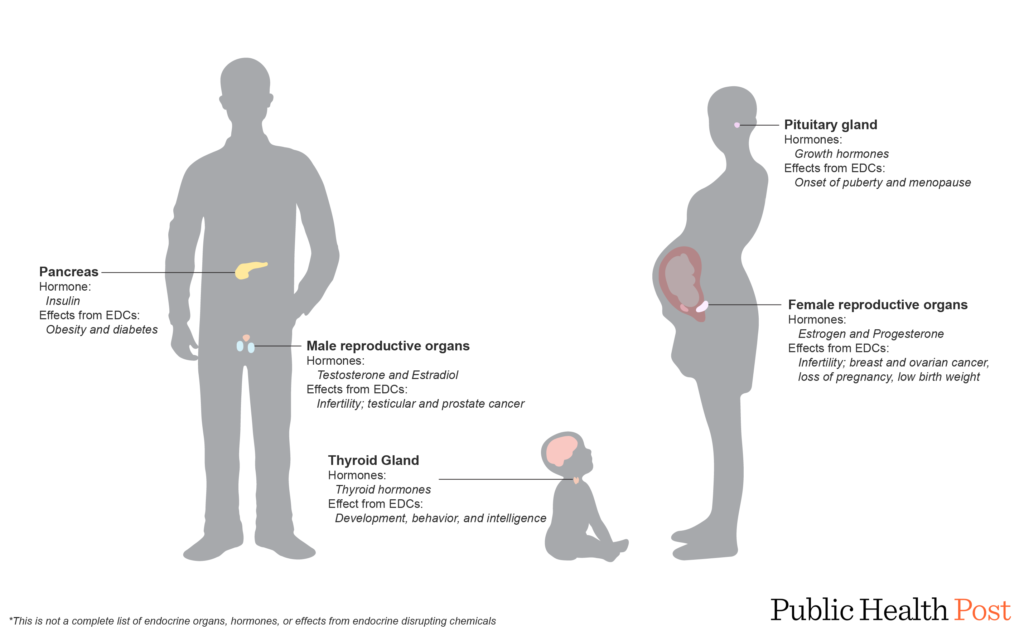Hormones control more than our moods. They control when and how we develop and age, how we handle stress, our metabolism, sleep, and fertility. Our bodies are constantly balancing the levels of over 50 hormones that adjust throughout our days and lives like switchboard controls directing our growth, behavior, and physiology. Disruptions to this delicate balance can interfere with development, reproduction, and cellular function.
A class of chemicals called endocrine disrupting chemicals (EDCs) have been the subject of serious concern in recent years due to their ability to interfere with hormones. Various EDCs have been used in household and chemical products for decades in plastic toys and water bottles, in pesticides, and flame-retardant couches, mattresses and household linens. Over 800 chemicals have been linked to a growing list of health conditions.
Identifying and proving that a chemical is the sole cause of disease when people are exposed to many things that affect health throughout our lives is scientifically challenging. Despite strong evidence from laboratory tests, the lack of observed population outcomes was used as an excuse by regulatory agencies for decades to avoid cracking down on the chemicals. The US largely ignored the warnings from laboratory findings and failed to act in time to prevent harm to people. Harmful effects from EDCs are now evident in the human population.

Reproductive Harm is in the Air and Elsewhere
Multiple studies have found fertility rates to be lower and loss of pregnancy to be more common in people with higher levels of EDCs in their urine. Even slight exposure to EDCs is harmful and linked to higher rates of genital malformation in males and lower semen quality.
Disrupted levels of estrogen can affect cellular function, leading to cancerous growth. California, a state rich in agriculture, observed higher rates of estrogen-sensitive cancers, such as prostate and breast cancer, linked to endocrine disrupting pesticides, including the tripling of breast cancer risk in those exposed to airborne chlorpyrifos.
Disrupted Development
Brain and thyroid hormones are responsible for guiding proper development. As early as 2007, researchers observed that infants exposed to EDCs in utero through their mother’s blood had an increased risk for developmental, cognitive, and behavioral disorders. EDCs were found to be responsible for a deficit of two IQ points in affected children, similar to the cognitive effects of lead exposure.
Understanding the physiologic link between these chemicals and our hormones tells us that the list of harms will continue to grow if we do not heed scientists’ warnings and act.
EDCs have also been found to influence the onset of puberty and menopause. Hormonal disruption during these crucial stages of development can have long-lasting effects on both physical and mental health.
Here to Stay
The hormones of future generations are at risk. EDCs do not decompose in the environment, earning them the honorary title: ‘forever chemicals’. Once inside our bodies, EDCs disrupt hormones that activate and deactivate our genes and control gene expression. These changes are epigenetic, meaning that the gene-altering effects of EDCs may be passed on to offspring.
What Are We Waiting For?
Just as firm evidence of human harm from EDCs accumulated, the Trump administration has blocked its use as a reason to regulate, a decision lobbied for by the chemical industries that stand to profit from continued production of EDCs.
Multiple other countries have curbed their use of EDCs, banning some chemicals entirely. In the US, the few regulations that have passed narrowly focus on children’s exposure through plastic toys. But EDCs are a danger to all ages through products, food, and our environment.
The growing list of health effects and the breadth of harm linked to EDCs should not have come as a surprise. Understanding the physiologic link between these chemicals and our hormones tells us that the list of harms will continue to grow if we do not heed scientists’ warnings and act. Regulations such as chemical bans, mitigation, and health monitoring should accurately reflect these chemical threats to our hormonal health.
Photo via Getty Images. Visualization by Tasha McAbee.














